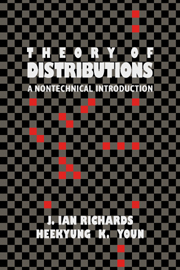Book contents
- Frontmatter
- Contents
- Preface
- 1 Introduction
- 2 The elements of distribution theory
- 3 Examples of distributions
- 4 Fourier transforms
- 5 Tempered distributions
- 6 Extension to higher dimensions
- 7 A general definition of multiplication and convolution for distributions
- Appendix 1 Partitions of unity
- Appendix 2 The Structure Theorem
- Appendix 3 Proof of Theorems A and B from Chapter 7
- Bibliography
- Index
7 - A general definition of multiplication and convolution for distributions
Published online by Cambridge University Press: 06 January 2010
- Frontmatter
- Contents
- Preface
- 1 Introduction
- 2 The elements of distribution theory
- 3 Examples of distributions
- 4 Fourier transforms
- 5 Tempered distributions
- 6 Extension to higher dimensions
- 7 A general definition of multiplication and convolution for distributions
- Appendix 1 Partitions of unity
- Appendix 2 The Structure Theorem
- Appendix 3 Proof of Theorems A and B from Chapter 7
- Bibliography
- Index
Summary
Introduction
The definitions of multiplication and convolution which we have used so far, while adequate for many purposes, are subject to severe limitations. Basically they are unsymmetrical. Thus, for multiplication, we have defined the product gT only for certain C∞ functions g, although we allow complete freedom for the distribution T. Similarly for the convolution S * T, we required T to have compact support, while allowing complete freedom for S.
For many purposes in analysis, one needs symmetrical definitions. Thus the product of two continuous functions g(x)h(x) is well defined, whether the first function g is C∞ or not. In a sense, the ‘good’ qualities of h (being continuous, rather than a general distribution) balance the ‘bad’ qualities of g (not being C∞). The point is that such a simple and important case as this – the product of two continuous functions – is not defined within the traditional theory of distributions.
There are two ways out of this difficulty. The first (and by far the most often practiced) is simply to acknowledge that distribution theory is a partial theory – sometimes useful and sometimes awkward. Accordingly, if one wants to multiply two continuous functions g and h, one passes out of distribution theory into classical analysis, multiplies g and h in the standard way within classical analysis, and then passes back into distribution theory. This works perfectly well, but from the viewpoint of distribution theory it seems slightly unfortunate.
The second approach is to expand the distribution-theoretic definitions of multiplication and convolution to cover the cases routinely encountered in analysis. That is what we will do in this chapter. Here we state a few cautions.
- Type
- Chapter
- Information
- The Theory of DistributionsA Nontechnical Introduction, pp. 104 - 134Publisher: Cambridge University PressPrint publication year: 1990



